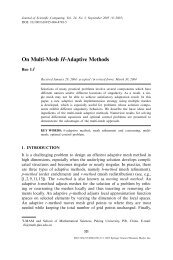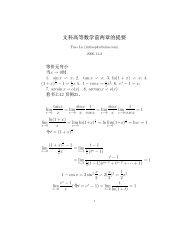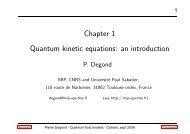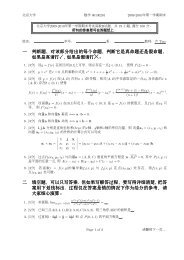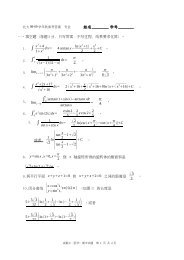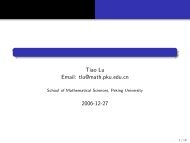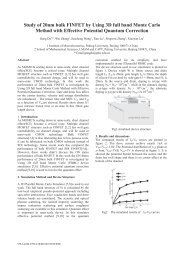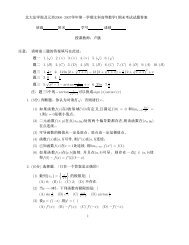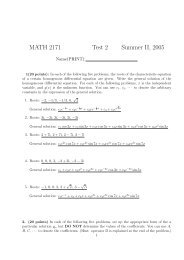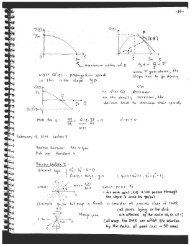fourth order chebyshev methods with recurrence relation
fourth order chebyshev methods with recurrence relation
fourth order chebyshev methods with recurrence relation
You also want an ePaper? Increase the reach of your titles
YUMPU automatically turns print PDFs into web optimized ePapers that Google loves.
2052 ASSYR ABDULLE<br />
10 4<br />
10 3<br />
sec<br />
BRUSS-2D<br />
ROCK2<br />
RKC<br />
RADAU5<br />
ROCK4<br />
error<br />
100 10−3 10−6 10−9 10−12 102 Fig. 5.2. Work-precision diagram for the two-dimensional Brusselator problem.<br />
<strong>with</strong> initial conditions<br />
u(x, y, 0)=22· y(1 − y) 3/2 , v(x, y, 0)=27· x(1 − x) 3/2 ,<br />
and periodic boundary conditions<br />
u(x +1,y,t)=u(x, y, t), u(x, y +1,t)=u(x, y, t)<br />
for 0 ≤ x ≤ 1, 0 ≤ y ≤ 1, t≥ 0. The function f is defined by<br />
<br />
2 2 2 5 if (x−0.3) +(y − 0.6) ≤ 0.1 and t ≥ 1.1,<br />
f(x, y, t) =<br />
0 else.<br />
We discretize the space variables of equations (5.5) <strong>with</strong> xi = i<br />
N+1 ,yi = i<br />
N+1 ,i=<br />
1, 2,... ,N and choose N = 128 and α =0.1. Thus, we obtain a system of 2N 2 =<br />
32768 equations. We chose the output points t out =1.5 and 11.5. The spectral radius<br />
of the Jacobian ρ 13200 can be estimated <strong>with</strong> the Gershgorin theorem; thus as in<br />
the previous example, we provide a bound for it when using Chebyshev <strong>methods</strong>. As<br />
advised in [7, p. 157] the linear equations in the code RADAU5 are solved by FFT<br />
<strong>methods</strong> so that the code is optimized for this problem. (Otherwise it will certainly<br />
not be competitive <strong>with</strong> Chebyshev <strong>methods</strong>.)<br />
We see in Figure 5.2 that ROCK2 and RKC behaves similarly. For higher <strong>order</strong><br />
<strong>methods</strong>, RADAU5 behaves better for low tolerances, while ROCK4 is better for<br />
higher tolerances. Between Chebyshev codes, except for very low tolerances ROCK4<br />
gives the best results and nicely preserves the tolerance proportionality (as do ROCK2<br />
and RADAU5).<br />
Example 3. The third example is the FitzHugh and Nagumo model for explaining




